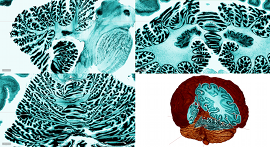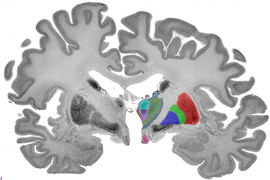Reference brains are essential tools in brain mapping research, making it possible to relate data to an anatomical standard space. However, the available reference brains have been restricted to the macroscopic scale, and do not provide information at the microscopic scale. BigBrain is an ultrahigh-resolution three-dimensional (3D) model of a human brain with resolution of 20 micrometers, close to the size of individual neurons, the result of collaborations between our lab and the German Forschungszentrum Jülich as part of the European Human Brain Project.
BigBrain was created from the reconstruction of 7404 histological sections obtained by cutting a paraffin embedded brain of a 65 year old male. This histological processing was done using a large-scale microtome in Julich. Histological defects including rips, tears, folds, distortion (shear), stain inhomogeneity, crystallization, as well as missing and displaced pieces were corrected using both manual and automatic repairs to restore the integrity of all sections, and then the 3D reconstruction of the whole brain as a contiguous volume was carried out. Massive calculations were carried out on high-performance computing (HPC) facilities within the Compute Canada network. The reconstruction of the 3D model brain takes advantage of recent progress in computing capacities and image analysis to overcome many challenges, including the highly folded cerebral cortex and the sheer size of the brain, with its 86 billion neurons. The dataset is very large in memory compared to previous brain atlases because of the higher resolution, a total of 1 Terabyte.
BigBrain is also a free, publicly available tool that provides considerable neuroanatomical insight into the human brain, thereby allowing the extraction of microscopic data for modeling and simulation. Existing brain atlases do not make it possible to extract information at the level of cortical layers, columns, microcircuits or neurons. However, anatomical information at the microscopic scale is crucial in order to understand the neurobiological basis of memory, language, emotions or other neural processes. BigBrain could make it possible to better understand brain organization, potentially integrating information across the microscopic and macroscopic levels, linking data at the level of cells with their specific connectivity to the level of cognitive systems and the whole brain. BigBrain enables testing of hypotheses on optimal path lengths between interconnected cortical regions or on the spatial organization of genetic patterning, redefining the traditional neuroanatomical maps such as those of Brodmann and von Economo.
For more information about BigBrain, consult the article published in Science.





